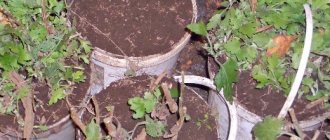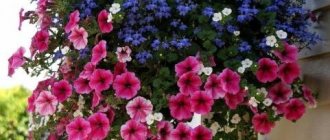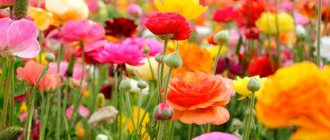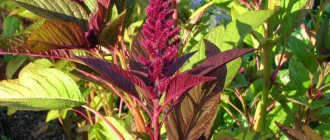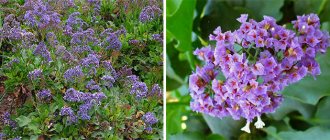Gazania rigens is a popular and easy-care plant found in gardens and balconies. From July until the first frost, it is showered with bright flowers that resemble miniature gerberas. Although gatsania is known as an annual plant, biologically it is perennial, but not winter hardy. Having overwintered in the room, the flower will delight us in the greenhouse next season.
From this article you will learn how perennial gats look like, planting and care features, photos of the most beautiful flowering varieties. Here's an easy way to winterize so you can enjoy the vibrant colors again next year!
Annual and perennial gats - growing and care in the open field
Gazania (gazania) gazania rigens - harsh or shiny. The name comes from the name of the Greek philosopher and humanist Theodore Gaza.
Short description
It grows in its natural environment in South Africa and Australia, in our area it is not very well known. Belongs to the family Asteraceae L., belongs to the higher order of dicotyledons. Like a chamomile, it is suitable for group plantings, including perennial compositions.
In nature, it is often found in the lower parts of alpine meadows. Grows in South Africa, Mozambique, Tanzania, Angola, grows rapidly in Australia, New Zealand, California, Mediterranean. Due to its exotic origin and external resemblance to chamomile, it is called African chamomile. Perennial gazania has long narrow leaves, whole or patchwork. Leaves are:
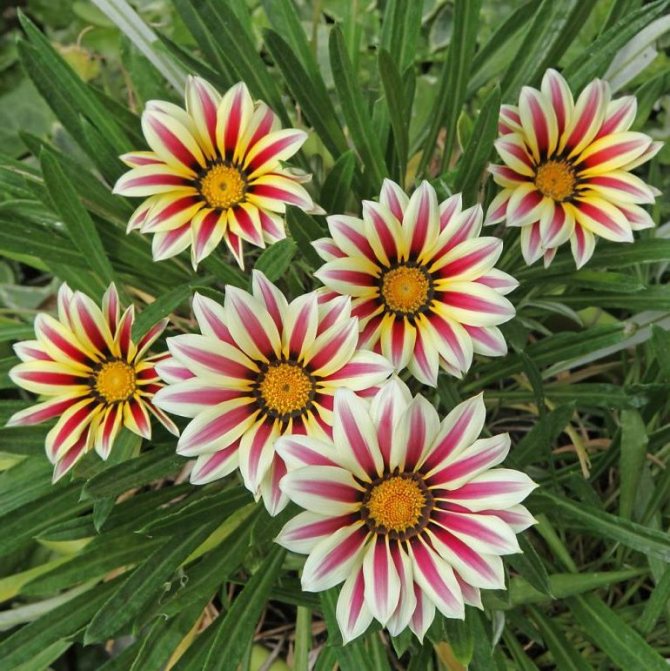
The stem is surrounded by leaves forming a rosette. The leaf blade is covered with hairs below.
Plant care is simple.
The flower blooms in various colors:
- white;
- cream;
- yellow;
- Orange;
- red;
- rose red;
- pink-lilac;
- red brown.
Photo. Perennial plantings of gazania
Sometimes the middle is shaded: inside it is darker, outside it is lighter. The most common variation is yellow.
Flowers close on cloudy, dark days, open on sunny days. This is one of the most characteristic features of gatzania. Not suitable for cutting, precisely because of the closure of the buds.
Photo. Closed gatsania buds on a cloudy day and at night.


The plant is undemanding to care for, rarely gets sick, if you provide it with the right conditions when planting.
Location, soil requirements, watering, fertilization
It is best to plant the gazania in a sunny location. Even in slightly shaded exposures, if there is not enough sunlight, perennial flowers will not grow. On cloudy days and rainy years, gatsania blooms poorly, the flowers remain closed, fall off.
Gatsania flowers, photo
Perennial African chamomile needs to be planted on fertile, not too wet, well-loosened garden soils. The pH value of the soil does not matter. On highly permeable soils, gating requires frequent watering for the first two weeks after planting. When a perennial young plant takes root, it suffers a short-term drought - it becomes easier to care for.
The peculiarity of a perennial plant is that it tolerates drought well. If there is a lack of water, flowering is weaker, so it is recommended to water the gats well in hot and dry weather. You do not need to water the plant too often, abundantly, it is enough to water as the soil dries up.It is better to moisten the soil in the morning so that the water remaining on the leaves can dry out before night. Such care for gatsania will allow you to avoid fungal diseases on perennial bushes.
Some growers advise, to make the gazania bloom longer and more abundant, constantly remove faded flowers and add a little dressing with each watering.
It's worth knowing! To prolong the flowering of gatsania, you need to cut off the faded flowers.
Gatsania can be planted in flower beds, flower beds, rockeries, in containers, at home in a pot. Perennial African chamomile grown in a container is more demanding to care for - you need regular watering and fertilization. Excessive irrigation of potted perennials should be avoided because they do not tolerate waterlogging well. Wait until the soil is dry until the next watering. At the bottom of the pot, drainage and a protective drain are required. Every 14 days after planting, the flower is fed with fertilizer for perennial flowering plants.
Photo. Perennial home gating on the windowsill
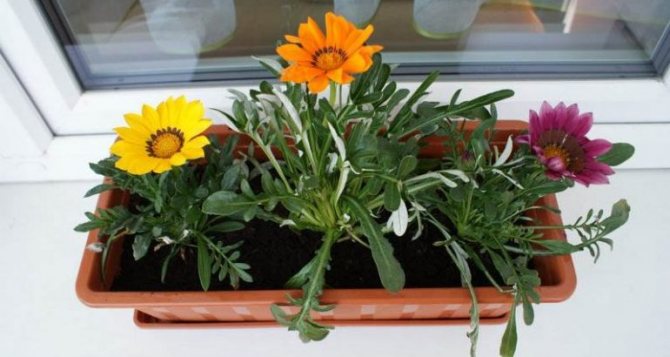

How to keep gating in winter?
Gazania brilliant is usually grown as an annual plant, but under appropriate conditions, you can give it the opportunity to be perennial, keeping the bushes for the winter.
In order for the plant to overwinter and become perennial, prepare for winter. The stages of work are as follows:
- You need to cut off all flowering shoots.
- Before the first frost, an African flower is dug out of the soil and planted in a pot.
- The pot is placed in a dry place, well lit by natural light, where the temperature does not drop below 0 ° C in winter. The optimum wintering temperature for gatsaniya is 5-10 degrees Celsius. The potted substrate is kept slightly damp throughout the winter so as not to dry out the roots. In this way, the preservation of the flower is carried out until next year;
- At the end of February, the plant is divided and transplanted into fresh soil. During the next stage, the pot is moved to a warmer, brighter room (the air temperature is maintained at 15 ° C) and watering is started more often in order to slowly awaken the perennial from winter dormancy.
- After May 15, in cold regions in early June, when the risk of frost has passed, you can start planting in open ground.
Planting and caring for the plant
Osteospermum choose an annual or perennial culture
You cannot even imagine what pleasure a perennial or annual gazania grown with your own hands will bring you. Planting and caring for it is pretty simple, and the result will be fantastic, profuse flowering.
Planting is best done in late May - early June, when the last night frosts have passed. Choose a sunny area with light and fertile soil for gassing. The plant tolerates drought easily, so don't be afraid of direct sunlight.
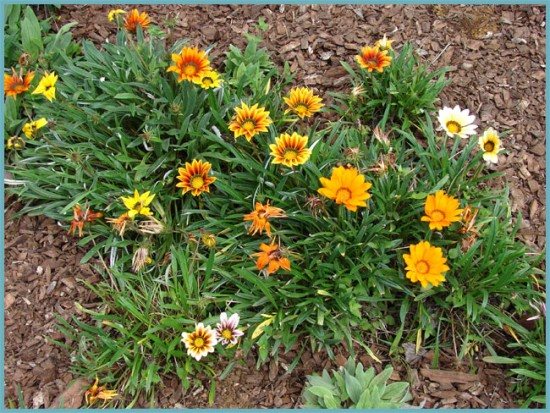

Be careful when transplanting gazania into open ground: the root system of the culture is very delicate
In open ground, seedlings should be transplanted with pots or an earthen clod so as not to damage the root system. The distance between plantings should be about 20 cm. Gatsaniya blooms from the beginning of summer until winter.
Attention! Gatsania does not tolerate excessive moisture. It is not necessary to fill it with water, as this will lead to rotting of the plant.
In this case, it is worth providing her with a good drainage system.
This unique plant will withstand the first autumn night frosts quite firmly, if they are replaced by warm sunny days.
Do not forget to loosen the soil in a timely manner, remove weeds that interfere with the normal development of the plant, and also remove wilted inflorescences.Mulching the soil will help retain moisture during dry periods and will inhibit the rapid growth of weeds.


So that the plant uses moisture optimally - mulch the soil around it
If you want to grow the crop as an annual, then at the end of flowering, the remnants of vegetation can simply be destroyed.
To try to preserve gazania until next year, the flowering bushes must be carefully dug up, transplanted into boxes and stored at about 10 degrees. Remember to provide them with good lighting and moderate watering.
Cut the shoots in half. In the spring, the bushes are again planted in the ground.
Growing gatsania seedlings from seeds at home
When choosing when to plant gatsania grown from seeds, it is worth taking into account the climatic zone. Plants are planted in the ground when the danger of frost passes - in the second half of May.
Read also: Orchid pirate picoty photo
Gatsania seeds are harvested after flowering. They look a little weird because they are very hairy. Seeds are spread in an even layer on a sunny windowsill. When they are dry enough, fold in an envelope for storage. There is no need to refrigerate the seeds.
Photo. Gatsania seeds.


Sowing seeds
- Seeds are sown in February - March.


- Sowing is carried out in pots, gatsaniya germinates quickly enough, after 2-3 days. In cold climates, it is worth pushing the sowing date as far as possible to a later date, otherwise the seedlings will be too early. Cover the seeds with a thin layer of film, maintain the room temperature at 25 ° C, sufficiently high humidity.
- February. Shoots in 3 days.
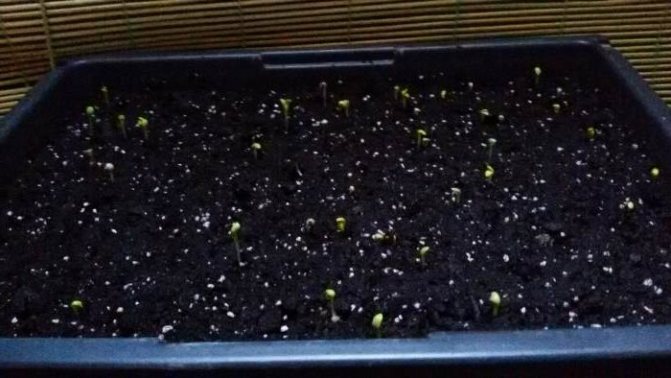

- Seedlings after 2 weeks.
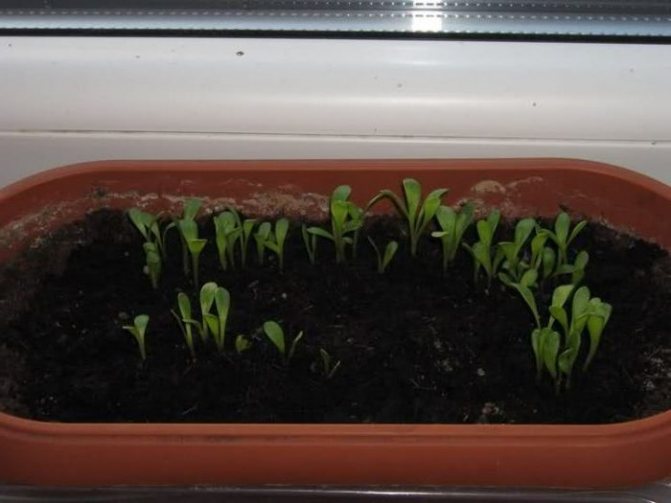

- Early March.


- 20th of March. After the plant ripens (about 3 weeks), a pick should be made, planting in pots of peat.


- In a week. When transplanting, flower pots are selected with a diameter of 9-10 centimeters. The temperature is maintained at least 18 ° C.


- Seedlings in May. In open ground, seedlings are planted in 20 × 20 cm increments.
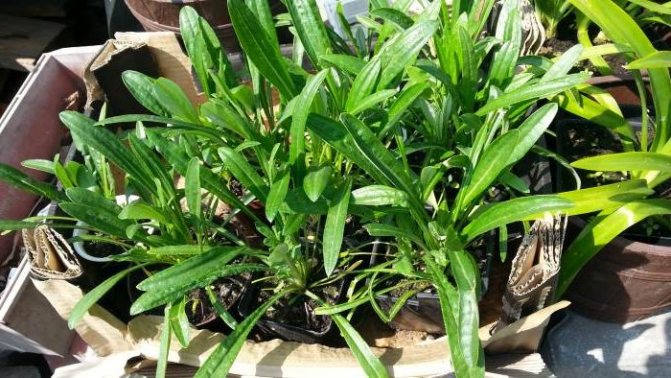

You can sow seeds directly into the ground at the end of April, the plants will bloom in about a month.
Gatsania can be propagated with your own or purchased cuttings. For vegetative propagation, the mother plant must be large in size and have healthy leaves.
Propagation by cuttings
This method of propagation has not become widespread due to the fact that plants grown from cuttings do not have time to bloom in the open field before the onset of frost.
On a note!
However, some rare species of gatsania do not produce seeds at all, so they reproduce only by cuttings. Also, in this way, seedlings are prepared for growing in a room.
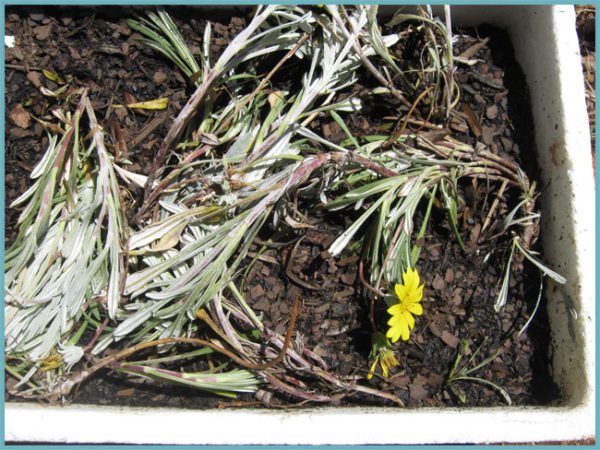

For grafting, choose a healthy and strong lateral shoot, cut it obliquely with a sharp knife, remove the lower leaves. It is better to choose a shoot with a heel - a thickening near the base. It is advisable to treat the cuttings with stimulating agents: Kornevin, Zircon, Epin, etc. Instead, you can use folk remedies: honey, aloe juice, yeast.
Next, the cuttings are dropped into the greenhouse, the soil must be moistened and disinfected. Rooting occurs at a temperature of 18 degrees and above, and a humidity of more than 60%
It is very important that the cuttings do not rot. How can you avoid this? Ventilate, prevent overflow, water with a weak solution of potassium permanganate
Or add ash to the ground.


The method of cuttings for growing gatsania is not suitable for all species, therefore, seed propagation is more often used, when planting on seedlings, it is described above and shown in the photo.
Diseases and pests
Gatsania does not have a tendency to disease, but in the process of cultivating it, it may happen that the flower becomes sick. A symptom of the disease may be yellowing of the leaves and deformation of flowers. There are also infections that directly attack the kidneys. The infected plant will have to be thrown away along with the soil in which it grew.
If silvery spots appear on the leaves, they are usually thrips. The bushes are treated with a suitable insecticide in the form of a solution. After applying insecticides 2-3 times within 10 days, the problem should disappear.
If white foam appears on the leaves, remove it with a jet of water.
Threatens the delicate leaves of the snail. They also damage the gatsania roots. The snails must be collected systematically.
If aphids appear on the leaves, they are removed with an appropriate insecticide. Usually, zolon 35% c.e. is used.
Pests and diseases of gatsaniya, how to care and control pests
If you create all the conditions for proper growth in gatsania, then you can not be afraid of pests: the flower will be fully able to resist them itself. But errors in care can create conditions for the appearance of pests and diseases. Most often, gatsaniya affects aphids, gray rot, spider mites, snails and slugs.
Aphid. Aphids are a very common pest that feeds on the sap of young plants. Plants infected with aphids weaken, stop blooming and bear fruit, and can easily become infected with various diseases. To destroy aphids, you can use insecticidal preparations (pyrimifosmethyl, bifenthrin, etc.) or folk remedies - infusions of garlic or tobacco mixed with liquid soap. You can also plant geraniums, onions or garlic next to the gatsania, the smell of which scares off aphids.
You can protect yourself from slugs and snails by sprinkling gravel between the rows
The main biological enemy of aphids is the ladybug, it feeds on these harmful insects. If ladybugs live in the garden, there is no need to fear an aphid invasion.
Gray rot. Gray rot is a botrytis fungus and fungi need water. To avoid infection with gray mold, do not plant plants close to each other, and when watering, you should try not to get on the leaves. If the fungus nevertheless "clung" to gatsania, treatment with fungicides, for example, foundationazole or euparen, will help.
Slugs and snails. These insects eat up the shoots and leaves of plants, preventing it from developing normally. Of course, modern insecticidal preparations will also affect snails, but their complete destruction is undesirable for the life of the garden - after all, in addition to healthy plants, they eat up and process their dead remains. Therefore, instead of the widespread destruction of snails and slugs, it is better to protect the most delicious plants from them - set traps, sprinkle inter-bed spaces with gravel, crushed shells or eggshells.
Spider mite. The spider mite is not an insect, so insecticides are useless against it. You will have to use insectoacaricides, phytovern or neoron. The spider mite has natural enemies - phytoseiulus and amblyseius, also mites, only predatory. These can be purchased at gardening stores.
In addition, watch the video on this flower, we wish you a pleasant viewing.
Bright large gatsania flowers will improve even the worst mood, and it is not difficult to grow it. And the African golden chamomile sun will bloom in the garden for everyone's joy.
Review of the best varieties with photos
There are several varieties of gazania. One of the most popular is gazania rigens (shiny, glossy). Also known:
- Gazania uniflora is one-flowered.
- Gazania krebsiana - characterized by red-brown flowers, up to 15 cm in height and 20 cm in width. The dark green leaves are shiny at the top and velvety at the bottom. Known in Africa as perennial gazania.
- Gazania longiscapa (gazania linearis) - found mainly in Africa, in the warm states of the United States (New Mexico, California).
Gatsania varieties are divided into groups:
- Kiss Kiss.
- Gazoo Gazoo.
- New Day New Day and Daybreak Daybreak.
- "Talent" Talent.
- "Mini Star" Mini-Star.
These are varieties of early flowering, flowers appear in June. Plants remain compact. Recommended for growing in containers. This is the richest group of varieties, among which the following are popular:
- "Frosty" Frosty - with a white coating on the leaves.
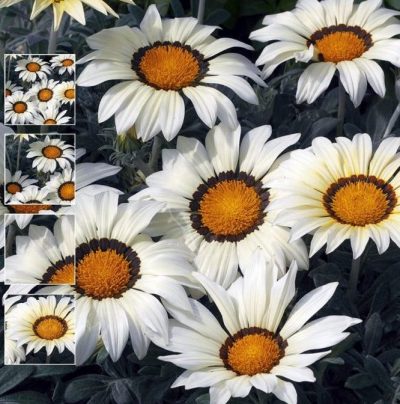

- White Flame - the sides of the petals are colored in contrast with a stripe that divides them in the middle.
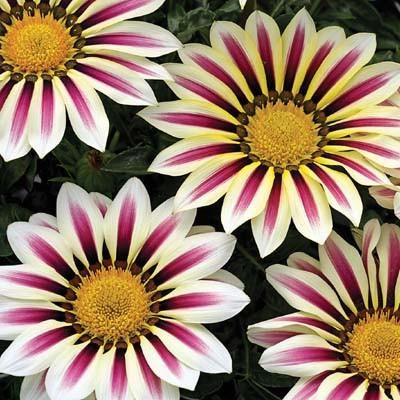

- "Bronze Star" Bronze Star - brown petals with a yellow tip and a green ring around the golden mean.
- Lemon Lemon Shades are lemon-yellow flowers with shaded petals.


- "Mahogany" Mahogany - hybrid gating harsh, mahogany flowers.
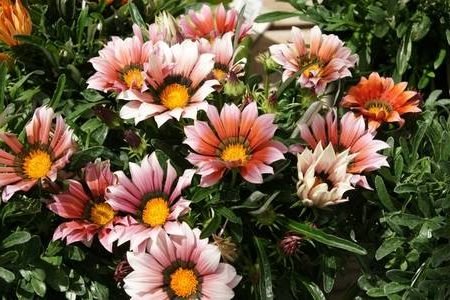

The group of varieties is characterized by abundant flowering throughout the summer. Pure flower petals. The main advantage is that the flowers remain open even in cloudy weather.
- "Pure Orange", "Clear Orange" Clear Orange - orange flowers.
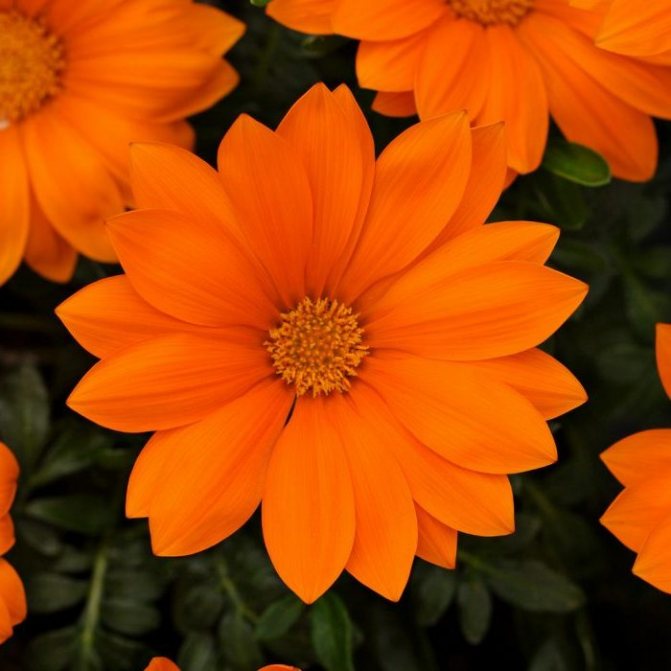

- Clear Vanilla or Clear Vanilla are creamy white flowers.


- "Pure Yellow", "Clear Yellow" Clear Yellow - yellow flowers.
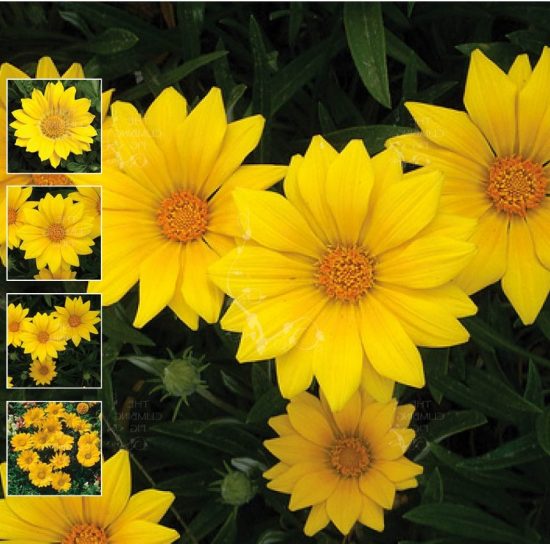

New Day and Dawn
The flowers of these varieties are larger than those of others (diameter - 10-12 centimeters), placed on short stems, retain the intense color of the petals, even when grown in weak sunlight. The buds open early in the morning and remain open until sunset.
- Rose Stripe Rose Stripe - petals with a dark pink stripe on a white background.


- Red Shades Red Shades - deep red flowers.
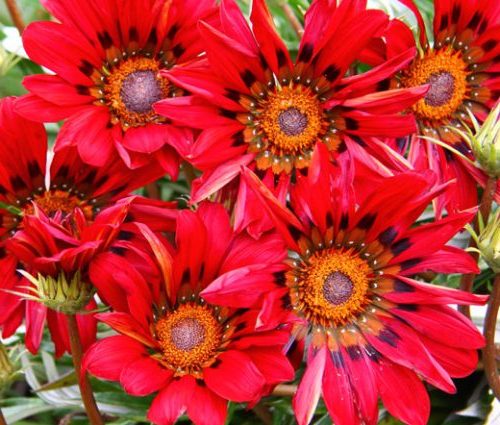

- Pink Shades Pink Shades are pink petals with lighter tips.


"Talent"
Varieties with decorative leaves and flowers that close at night. The leaves have an interesting gray color, attractive even when the buds are closed.
- Rose Shades Rose Shades is a hybrid gating with pink flowers.


- "Red Shades" Red Shades - inflorescences in a shade of rust.


- "White" White - white flowers with yellow class = "aligncenter" width = "600" height = "758" [/ img]
"Mini-Star"
Mini-stars are dwarf gazania varieties that grow to a height of 15-20 centimeters, forming regular spherical beams. Especially recommended for growing in pots. The flowers are small (6-7 cm in diameter), found in warm shades:
Sort "Mandarin" Tangerine - the petals and the middle of a uniform orange hue.
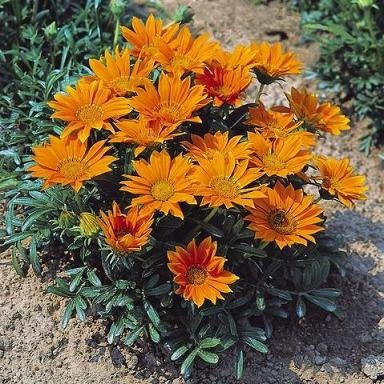

Conclusion
Gazania is a heat-loving, drought-resistant flower with a warm color, reminiscent of a bright chamomile or gerbera. Caring for the plant is not too difficult, and the petals and shoots are so beautiful that it would be a mistake to abandon the charming element in the garden. African chamomile will make the garden beautiful, bright, a little exotic.
Gatsania opens its flowers only when there is enough light, therefore it did not gain popularity in some regions. At the moment, there are varieties that are less sensitive to lack of illumination. This is especially true of varietal groups with the names Daybeek, Kiss, Gazoo. The flowers of the latter group are open, even despite cloudy weather.
Victoria Gatsania annual or perennial?
The question of whether a flower is an annual or a perennial is most often asked in relation to southern plants that grow in their homeland for more than one season, but are not able to winter in colder regions. Gatsania also belongs to such plants. In the middle lane, it is grown as an annual. But you can try to save the flower until next season.
Growing as an annual crop
Gatsania is a beautiful flower, reminiscent of the familiar chamomile, but with brightly colored petals. Native to South Africa, and there it is a perennial. Its other name is African chamomile. Among other flowers in the garden, gatsaniya is visible from afar. It stands out for its special grace and beauty of flowering. With proper care, it blooms for a fairly long period. To make her feel comfortable, she needs certain conditions:
- a sufficient amount of sun, in the shade it grows worse and will not bloom;
- no waterlogging of the soil, since the plant comes from arid places;
- planting in light, fertile, well-drained soil.
Read also: Co2 generator for greenhouses


In regions with a cool climate, gatzania is grown primarily as an annual crop. It can be quite difficult to preserve it during the winter, although some growers do it quite well.
Attention! Gatsania can only withstand short-term frosts, but with more prolonged cold weather, it will die.
16 excellent varieties of plums for the Moscow region
Can these flowers be grown as perennials
As a perennial, gatsania will grow in open areas only in warm regions without prolonged subzero temperatures. But how can you preserve your favorite variety of this plant during the winter in cooler climatic zones? Such an attempt can be made. This requires:
- in the fall, carefully dig out a gatsaniya so as not to damage its root system;
- transplant it into a pot or other suitable container with good drainage;
- place the plant in a well-lit place, you can on a windowsill or a warm balcony;
- water the plant in a timely manner and make sure that the room temperature does not drop below 10 degrees Celsius.
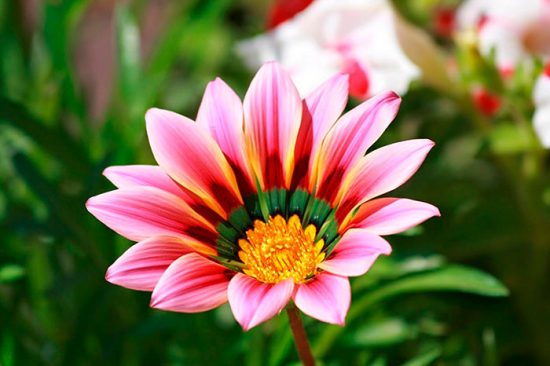

Subject to the necessary rules for caring for a flower, it may well turn out that it will persist for the next season.
Most growers grow gatsania as an annual, simply planting new seeds the next year. Indeed, in order to preserve the plant until spring and plant it again on the site, you will have to make a lot of effort, creating favorable conditions for the flower, and not everyone has the patience for this. Therefore, more often they do this only if they want to be sure to preserve a certain variety.
Gatsania care: video
Gardeners and ordinary people adore this flower for a riot of colors. Gatsania, a perennial or annual, really has a vibrant, exquisite beauty. And blooms like a multi-colored chamomile. These plants are native to Africa, which is probably why they like sunny days.
The bright sun, which gives warmth, allows us to admire such a creation of nature. And in the cold season, we can also observe such a plant as gatsaniya. How to preserve these flowers in winter so that later in the summer they decorate the garden plot? Such questions are often asked on the forums of amateur gardeners.


The use of gatsania in landscape design
What year does hydrangea bloom after planting
In Africa, gatsania is grown as a perennial, but in European regions it does not survive the cold winter and is grown as an annual plant. Suitable for almost all types of climate, but in colder latitudes, it should be dug up in autumn. The plant does not like waterlogging and a lot of precipitation. Stably tolerates temperature fluctuations from -5 ° C to 35 ° C, with severe frosts it immediately dies.
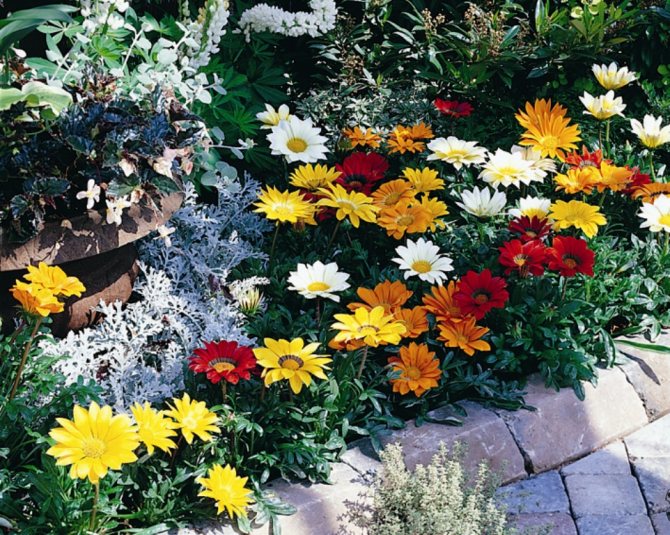

Gazania in landscape design
Gatsania - an annual or perennial - can be grown in containers and flower pots to decorate balconies and terraces. Suitable for placement in flower beds, in flower beds, along paths in the garden, on alpine slides.
Note! It is allowed to grow African chamomile as a home plant.
In the design of a flower garden, Iberis, Venidium, Lobelia can become its ideal neighbors. Avoid planting near too tall plants that will block access to light, such as verbena or delphinium. In the form of a cut, gazania lasts for about 8-9 days.
Hybrid plant varieties, among which harsh gazania and long-shot gazania are most often found, are grown as annuals. They can reach 30 cm in height, bloom profusely from mid-summer until the onset of cold weather. These varieties are distinguished by multi-colored reed petals, which makes them of particular interest to gardeners. Suitable for creating contrasting colorful mixes, bloom earlier and are more resistant to unfavorable weather.
There are also many other varieties, including peacock gazania, feathery, one-flowered. Peacock gazania has about 20 cm long leaves, covered with harsh hairs on top, juicy orange flowers with a yellow center and a black ring around it. The feathery gazania has a pinnate leaf shape and orange flowers with a dark mark towards the middle. The one-flowered variety is a compact plant with creeping stems and pale yellow baskets of numerous medium-sized flowers.
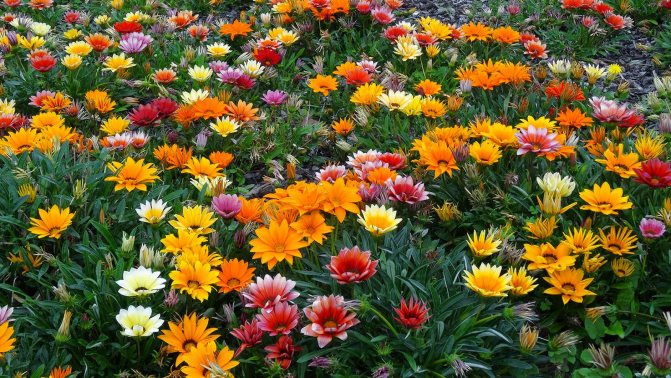

Different types of gazania
Types of gatsania
Gatsania belongs to the Astrov family. Such plants come in several forms: annual or perennial, subshrub or shrub.
They gained fame thanks to the variety of colors. In fact, there are quite a few varieties of this flower, they can be counted up to fifty.
The most popular are gatsanii shiny, or harsh. Our breeders have bred flowers of various colors. And now not only a monochromatic chamomile, but also a motley gatsaniya, the photo of which you see in the article, pleases us. The main varieties are gatsania one-flowered, shiny, peacock, white, feathery, etc.
South African chamomile
Four reasons to grow Asparagus pinnate at home
You would be surprised to know how many flowering plants come from South Africa - pelargonium, freesia, clivia, bacopa, gerbera, anthurium ... The list is endless. From the same campaign, gatsaniya is a herbaceous plant of the Astrov family, found in annual and perennial varieties.
At the beginning of the growing season, it forms a lush basal rosette of long feathery leaves of a dark green color. A powerful bush 25-30 cm high is able to expel up to 35 peduncles per season, each flower retains its decorative effect for an average of up to 3 weeks. The perennial is adapted to an arid climate. The taproot is able to extract moisture from the lower layers of the soil, and the underside of the leaves is covered with villi, which protect them from excessive evaporation.
The inflorescence of gatsania resembles a chamomile, but not European - white and modest, but South African - variegated and defiant. The flower basket consists of a tubular center and reed petals - different (monochromatic, variegated, with stripes), but always extremely effective. The ring pattern bordering the core of the flower looks unusual. Inflorescences open only in sunny weather. After sunset, on a cloudy day, the petals are twisted into a tube and collected in a bud.
The cold winter does not allow growing the plant in a perennial culture, therefore, most often gatzania is sown with seeds every year. The second option is transplanting into closed ground and wintering in a room with a positive temperature.
Plant features
This interesting southern specimen has its own uneasy character. It manifests itself in the fact that if it is cloudy outside, the petals close, and the middle of the flower becomes invisible.
Initially, these plants, accustomed to heat and light, could bloom from sunrise to sunset, but in bad weather they keep closed. But flower growers would like more. And then they, through trial and error, began to experiment on responding to weather conditions with this plant. And so, thanks to their actions, a hybrid called Talent appeared.
As a result, now you can admire the colorful shades of the flower in any weather. So our specialists, despite the plant's capricious mood, quickly found a way out.
Love African chamomile watering. It is advisable for them to arrange it systematically in the heat. If this is not done on hot days, then the flowers before our eyes will become smaller and smaller. And, of course, they will no longer be able to delight us with their beautiful coloring pages.


Planting and caring for gazania
Pick-up location
For this culture, areas are chosen that are located in completely open areas with strong sunlight and light, permeable, nutritious soils. Gazania does not tolerate excessive moisture, which causes a strong inhibition of plant growth and development.
| Despite the fact that this culture is thermophilic, it can tolerate slight frosts (-5-7 degrees). |
Gazania planting rules
To correctly determine the sowing time, you need to know that this plant blooms 3-3.5 months after sowing. Usually the beginning of flowering occurs in late June or early July, but later varieties bloom only in August. But at the same time, flowering lasts almost until the frost.
Planting gazania in the ground is most often done by seedlings. Seeds are sown in wide and low containers with light, permeable and nutritious soil in March. The optimum temperature for germination is between 18 and 20 degrees Celsius. Usually, the first shoots appear in 4-15 days. Young gazanias dive with two or three pairs of true leaves into separate small pots or cups, and then grow at 12-15 degrees.
Planting seedlings on the site must be carried out with a lump in order to completely preserve the root system. The time for this comes after May 15-20.
When planting gazania in a garden or flower bed, a distance of 15-20 cm is maintained between the bushes, for tall varieties up to 30 cm.
Let's talk about hybrid and long-shot gapping
Floriculture uses in our latitudes mainly hybrid and long-shot gating. Long rifle gatsaniya native to South Africa. This type of gatsaniya is a perennial. Grows with short and creeping stems. It blooms from August until the beginning of winter. These flowers are seven centimeters in diameter.
Hybrid gatsania has a harsh structure, and the flower is 8 cm in diameter. It can be specified in any shade of orange, as well as white and yellow. It grows as a bush in a rosette of basal leaves.
The hybrid flower is distinguished by the decoration of the leaves. They have a linear spatulate structure. Leaves with a shade of silver underneath, resemble velvet to the touch. By the way, such pubescence is not accidental. Thanks to him, the plant is not afraid of the cold. In addition, the leaves help to retain moisture on the flower.
Hybrid varieties are more in demand among our compatriots. The fact is that they have perfectly adapted to our climate. They have large flowers and a large number of semi-double or double petals. And a lot of hybrids and main varieties have been bred. And they bloom in white, crimson, pink, yellow, bronze-lemon, cream, orange, striped and spotted flowers.
Their names are suitable for color. For example, there are the following names for varieties (mixtures of varieties): Sunny flare, Sunny dance, Wonderful miracle, Sunshine, Sunshine, Big kiss, Bonjour and so on.
Description and main characteristics of gatzania
The South African gatsania (or gazania) flower looks a bit like a chamomile in appearance, which is why it was called that. This is a stunted plant of the Astrov family, which came to Europe in the middle of the 18th century, and was named after the Italian priest T. von Gaza. In the wild, it grows in Africa and coastal areas of Australia.


Gazania flower
Gatsania flowers are formed on a smooth, tubular stem 25 cm high and reach a diameter of 5-12 cm.The color depends on the variety and can be almost any: snow-white, rich or pale yellow, orange, all conceivable shades of pink, red. A distinctive feature is the darker and more contrasting strokes going to the center of the flower.
For your information! The plant begins to bloom 3-4 months after planting the seeds. Its duration is determined by climatic conditions.
Gatsania has a flexible aerial part creeping along the ground, a taproot. The leaves and stems are fleecy, silvery; milky juice appears on the cut.The upper part of the leaves is smooth, bright or dark green. Seeds are thin, elongated, black and white, with a small crest.
How to care
After two weeks of planting, feed the gats with mineral fertilizers. If there is poor soil on the site or flowers grow in a container, then use complex fertilizers, but also after a while, within 14 days.
Be sure to feed a plant such as gatsania at the beginning of the season. Cultivation and care, properly organized, are those actions that will help her to constantly delight you with her flowering.
Read also: Origami paper lily diagram
The most favorable soil for gatsania is sandy loam. It should not be waterlogged. And, what is important, there should be a lot of humus in it. When the flowers gain strength, the feeding can be canceled. Remove constantly faded inflorescences and peduncles.


The beauty of South African chamomile
Gatsania or, otherwise called gazania, is a perennial plant belonging to the Aster family.
If you once see a package of seeds with a photo of gatsania on the counter of the store, be sure to purchase, because gatsaniya is a unique and unpretentious plant that will delight you until the onset of the first frost!


Perennial plant belonging to the Aster family
The shape of the gatsania flowers resembles everyone's favorite chamomile, only of a larger size, and simply amazes with its rich color palette. This is the result of hard work and many years of breeders' work.
In the manuals for florists, you can find a detailed description and photos on planting and caring for gatsania.


The shape of gatsania flowers resembles everyone's favorite chamomile.
Gatsania obtained as a result of hybridization is quite common and popular among flower growers, as it has a number of advantages over many plant species.
How such flowers feel in winter
Such a unique flower as gatsaniya, care, careful and thoughtful, is necessary, however, like all plants. But it won't be too burdensome for you. The plant needs light, fertile soil with good drainage.
When the flowers mature, they become cold-resistant, you can admire them almost until the first frost. Although gatsania, a perennial or annual, is a native of the south, it has almost adapted to our latitudes.
Only when you already feel the onset of winter, carefully transplant your favorite flowers into pots. If you have a glazed balcony and the temperature there is not lower than +10 degrees, then they will winter well in this place, in order to return to the garden plot in spring. Do not forget about moderate watering.
Try to transplant flowers very carefully so as not to damage the roots. You can also use flowerpots in areas for growing a plant such as gatsania. How to keep such flowers in flowerpots in winter? Do not transplant them from pots, but simply take the flowers home with them.
Gatsania flower description
We get acquainted with a bright representative of the Astrov family, a guest from South Africa - gazania (gatsania). Gazania in indoor floriculture and in the open field is represented by many hybrids.


Gatsania flower (gazania)
Gazania is considered a perennial plant, but only where there are no cold winters, we grow it as an annual. If you really liked a particular variety, then you can save it by planting it in a pot and setting it on the windowsill until spring. If you provide the plant with good lighting, then gatsania will bloom in winter.
Gazania inflorescences open only in sunny weather. At dusk and on rainy days, the inflorescences close.
Gazania is a stunted plant, which is dense green leaves collected in a rosette. There are also species in which the leaves are covered with a silvery down. Depending on the variety, gazania and leaf shapes are different.
Numerous gatsania flower stalks rise above the leaves, and beautiful, large inflorescences are formed on them.Gatsania bloom begins in mid-summer and lasts until frost. There are varieties of gazania that can withstand short-term frosts.


Gatsania in the garden
In floriculture, hybrid gazanias are most often preferred, since they have a denser and more compact leaf rosette, large inflorescences with an unusual color.
Can a flower overwinter?
In order to keep gating until spring, there are several ways:
1. In winter, the flower will be good indoors. Only good lighting will be needed. The plant is unpretentious. If you live in a region with mild, wet winters, free from frost, then you don't even need to take the pot home.
Although they love warmth, as they grow up, the flowers adapt to the local climate. You can use special containers to grow in your garden. And then, with the onset of cold weather after -3 degrees, pick them up, put them on the balcony, so that she could get used to the new gating conditions.
Plant wintering can then continue in warm rooms, but only after the flower gets used to the balcony climate, where the optimal temperature for it will be 9-11 degrees with a plus sign.
2. But if you live in a frosty winter area, it is best to grow gatsanias as annuals. To do this, you can sow gatsania seeds in early spring. Try to water the plants in winter, but very rarely. And make sure that the soil does not dry out. Gatsania (cultivation and care in this case will not be very different) can grow if you either did not transplant it from the pot, or carefully, without damaging the roots, tried to transplant it.
Gatsania-perennial is a low-growing bushy plant, therefore, when you transplant it to open soil, carefully separate the bushes.
Gazania growing from seeds
Diplomas
For crops, you can take a box or cassettes with cells. In the first case, the seeds are laid out at a distance of 1 cm from each other. In the second - in each compartment a seed and no picks in the future.


The seeds are large and the work will not be as painstaking as, for example, with petunias. The ground must first be well moistened. It is unnecessary to cover planting material with soil. But if you really want to, let it be a layer of 2-3 mm vermiculite. Cover with foil or glass. And do not forget to ventilate the crops, otherwise the mold will sprout faster than the first shoots!
Place your cherished soil and seeds in a sunny spot. After 5-7 days, the joy of the first shoots will warm the soul. There will be latecomers, but before 2 weeks from the moment of sowing, you should not be sad. The green long cotyledons of the plant will still have time to be born.
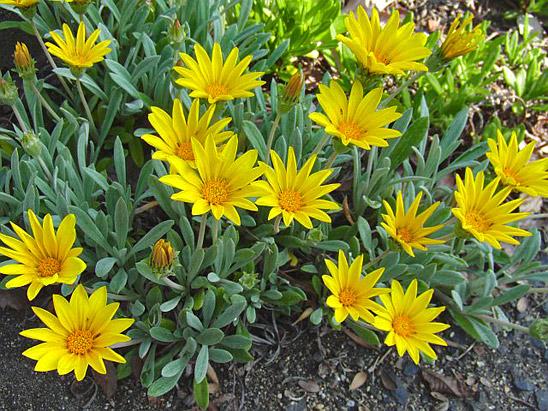

How I love to deal with the seedlings of this amazing flower. Experts say that it is necessary to dive when the kids have 2-3 real leaves. But, excuse me, I have no patience! And green newborns do not resist my haste! I settle my children in separate potty apartments even at the stage of cotyledons. Immediately after receiving a separate living space, they seem to be competing with each other, striving upward.
The book data promises that the first flower will appear after the 5th leaf. This was not the case for me last year. Gatsania tormented me a little, extending the wait for flowering to 7 leaves. I don’t know, maybe I offended her with something?
I noticed one interesting feature of seedlings. For a long time, its leaves were light green, sluggish, almost lifeless. I tempered and fertilized her, but she doesn't like everything. And when in mid-May I sent her to the flower bed, a miracle happened. In the morning I make the usual detour of my possessions, and there - a marvelous wonder! My light green Cinderella turned into a Swan Princess: the feather leaves became green with a carved edge, and from the very heart the first bud.
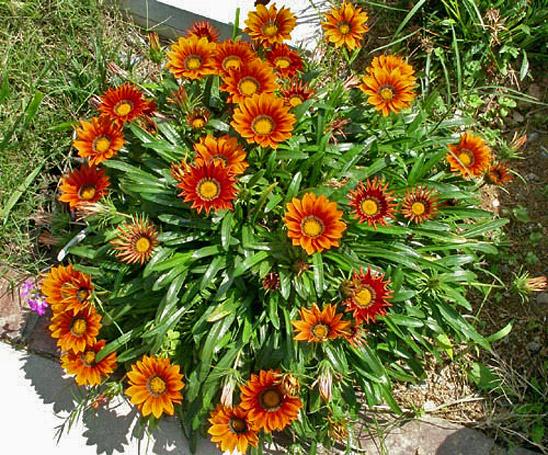

The next advantage of the flower is the beginning of flowering in mid-June. From the moment of sowing to the first bud, on average, it takes 90-100 days.For a long time, but what multi-colored fireworks from daisies are obtained in the end! A green pillow of leaves, and on it there are 20 or even 30 fire daisies.
Another plus! Winter is on the doorstep, and the gatsania does not calm down - it blooms and blooms. And she doesn't care about snow. It's always hard to part with her, so I dig it out carefully and into a pot. I cut the flowers, they will stay in the vase for at least another week. And I send the hero of the occasion for the winter to the garage, to the window. Sometimes I visit her and water it, and in May I again move it to a flower bed.
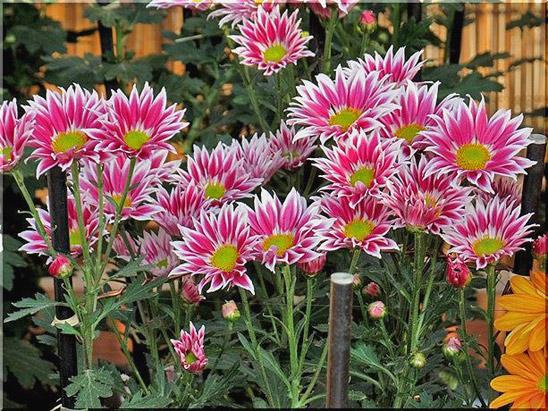

Believe me, it is better to try planting gatsania once and make sure that no photos can convey the beauty of flowers. Gazania grown from seeds is not inferior in strength and abundance of flowering to ready-made young growth acquired in garden centers. Therefore, you can safely save and buy seeds.
About seedlings
Gatsania is sown in the first month of spring. After the seeds have cut through, the seedlings must be sown in greenhouses or in earthen pots. And as soon as the spring frosts end, plant them in the ground.
We advise you to still use peat pots if you are growing a flower from seed. This is necessary in order not to accidentally damage the roots. And in this case, there will be no need to dive. So you will solve the problem of vital activity in the winter of a plant such as gatsaniya. We have considered how to preserve it in winter, as well as how to grow seedlings from seeds.
And already from April, the weather usually allows you to send seedlings to a cold greenhouse or to an open ground area. Seedlings must be gradually hardened. This can be done from the moment the thawed spots disappear.
The shoots will gradually get used to cold up to -3 degrees and bright sunlight. If you notice that the temperature is lower at night, use lutrasil to cover the young growth. At an outdoor temperature of more than +17 degrees, shoots should be expected in a decade or a little later.
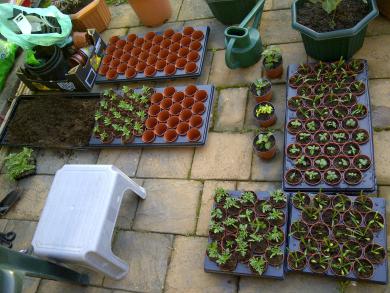

Reproduction of gazania
Gazania is propagated using seeds and cuttings. Seed propagation is described in the planting section. Let us consider in more detail the rules for propagation by cuttings.
Propagation by cuttings
By cuttings, mainly varieties with double inflorescences are propagated, which do not propagate by seeds.
- This operation is carried out in mid-July.
- Cuttings about 10 cm long are cut from side shoots taken from the very base of the plant.
- Leaves from the bottom of the shoot are cut off.
- To increase the number of young plants obtained and to reduce the rooting time, cuttings are treated in a solution of indolylbutyric acid (0.5%).
- After that, the cuttings are placed in containers about 10 cm wide, which are filled with loose and breathable soil.
- Rooting takes place best of all at 15-18 degrees Celsius, but at the same time the cuttings must be covered from direct sunlight and drafts.
- Roots are formed within 1-1.5 months.
- Rooted seedlings are taken indoors for the winter.
- Young bushes are planted in open ground in early spring.
How to propagate a plant using cuttings
Reproduction of gatsania can also be done using cuttings. Midsummer is exactly the period when gatsania, perennial or annual, quietly reproduces with the help of cuttings, which are obtained from lateral shoots at the base of the stems.
First, treat the cuttings with drugs that stimulate root formation, then plant them in the shade so that the sun's rays do not fall on them. It is necessary that they get used to the new place. When you see that the cuttings are rooted, take a clod of earth along with the cuttings and plant them in the place you have chosen.
In this way, gating will always grow on your site. How to preserve such a flower in winter, now you already know.


Rules for caring for a gatsania plant
Gatsaniya grows in almost any conditions
Among the many types of gatsania, you can find varieties that are adapted to almost any conditions.In temperate regions, gatsania is grown as an annual and requires little maintenance.
You can only admire the gatsin in all its beauty during the sunny season. It is unpretentious, in order for the plant to be comfortable, enough sun, well-drained soil and infrequent watering.
Like any other plant, it likes good soil, but if there are problems with fertile soil in your area, gatsania will easily adapt to poor soil with a large proportion of sand. In the future, she will need timely weeding, loosening the soil and watering. It is better to water the "African chamomile" rarely, but a lot, only after the topsoil is dry.
Fertilizing gatsaniya is enough once every one and a half to two months, if the soil in your garden is fertile enough. If not, then you will have to apply fertilizers much more often: once every two to four weeks.
Abundant flowering of gatsania is facilitated by the timely removal of faded inflorescences.
Flowering is possible only during the sunny season. She loves the sun so much that she closes the flowers at night and even in cloudy weather.
If gatsania does not bloom, most likely it does not have enough light and should be transplanted to a sunnier place.
Where can you plant gatsania?
They are planted on curbs, paths. Flower beds are arranged next to stones or stunted flowers. Unique flower arrangements with ageratums, lobelias and other floral creations will definitely not leave anyone indifferent. It turns out to be a wonderful sight that must be immortalized.
No one remains indifferent, contemplating such a gift from nature as gatsaniya. Photos are proof of that.
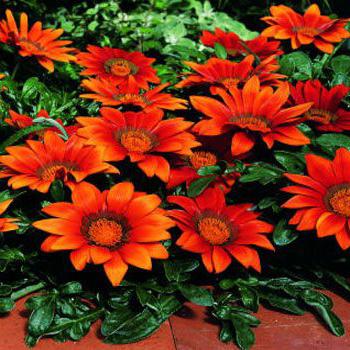

What does a gatsania plant look like?
Gatsania, or as it is called the South African "chamomile", is gaining more and more fans among florists and gardeners. Having once grown this beautiful flower, they strive to plant more and more interesting varieties of this plant next year.
Many people probably know what gatsaniya looks like, since she is a frequent visitor to flower beds and street flowerpots.
Outwardly, gatsaniya flowers really resemble chamomile, familiar to most of us from childhood. These plants differ in the color of the petals, since in gatsania they are painted in juicy and bright yellow-orange shades. Inflorescences - single baskets 5-9 cm in diameter, 30-35 per plant.
It belongs to the Asteraceae family and has dense rosettes of green leaves at the base. Starting from the last days of July, bare peduncles begin to appear from the rosette of the gatsania chamomile, slightly rising above the already existing leaves.
At the tops of the peduncles there are large inflorescences-baskets, which attract attention with their unusual color
However, if desired, they can be transplanted into pots for the winter and withstand the entire cold season on a balcony or veranda. Perennial gatsania in a warm climate perfectly survive the autumn-spring period and in the new year they also bloom magnificently and for a long time.
Is gatsania sick?
She can catch a disease called gray rot. As you can see, the gatsania plant can also get sick, like everything alive in the world. Growing (and caring for it) during this period will be slightly complicated by the fact that you will need to resort to the help of a fungicide.
Treat the diseased flower with its solution. Preventive measures will also be useful. They are simple: make the flowers grow in non-waterlogged soil.
Also protect them from aphids, snails, slugs, spider mites.
By performing such simple actions, you will constantly enjoy the vibrant exoticism of a native of Africa, and will delight you at any time of the year. Wintering is not terrible for her. So enjoy the sight of these lovely flowers!
Diseases, pests and ways to control them
Despite the plant's resistance to pests and diseases, improper care of gatsania and unfavorable conditions lead to damage by fungal or viral diseases, as well as the appearance of various pests.Due to insufficient lighting and excess moisture, gray rot forms on the plant, which can be eliminated only at the initial stage. For this, gazania is treated with fungicidal preparations.
Note! Bushes that have undergone severe infection are removed and burned to protect healthy plants from disease. The garden bed is treated with phytosporin for the same purpose.
Garden snails, which often eat the lower leaves of gatsania, are harvested by hand. By the yellowing and wilting of the leaves, one can suspect that the reason for this was the appearance of spider mites and aphids. The tick is destroyed using ditoxin, fufanon or actellic. Aphids are fought with the help of inta-vira, akarina or phytoverm.
Compliance with the rules of care will allow you to grow chic gazania bushes in your summer cottage. Perennial or annual, African chamomile will invariably delight with its unusual bright colors.
Features of gatzania
Gatsania can be either an annual or a perennial plant. The height of the bush is about 30 centimeters. Basal leaf plates are part of the rosette, while the stem is completely absent or it is very short. Dense leaf plates can be greenish-gray or dark green and have a wide variety of shapes. On the seamy surface of the leaves there are thick silvery villi, they protect the flower from cold weather, and during drought they help to retain water. Inflorescences look like single baskets, which can reach 5-9 centimeters in diameter. They include reed flowers, which can be red, orange or yellow in color. They have a dark spot at the base, resulting in a circular pattern around the center, painted yellow. The center includes tubular flowers. There can be about 35 such inflorescences on one bush. The fruit is a hairy achene with a tuft.
Varieties
2.1 Harsh or shiny gaggles - Gazania splendens, Gazania rigens
An attractive, large-flowered, perennial variety with a height of only 15 to 25 cm. Leaves are silvery green, long, narrow. The flowers are single, very large - they reach a diameter of 10 cm, resemble a chamomile, often painted in yellow, orange, pink and brown tones. The buds often remain half-closed in cloudy weather and at night.


2.2 Long-rifle gagging - Gazania longiscapa
Perennial flowering herb with abundantly branched at the base, strong, erect shoots. Leaves are green, narrowly oval, sessile, arranged in opposite pairs, leaf blades are entire, covered with light, silvery pubescence. During the flowering period, large inflorescences with a diameter of up to 8 cm appear at the tops of the shoots with many thin, orange petals and sometimes a dark, brown center.
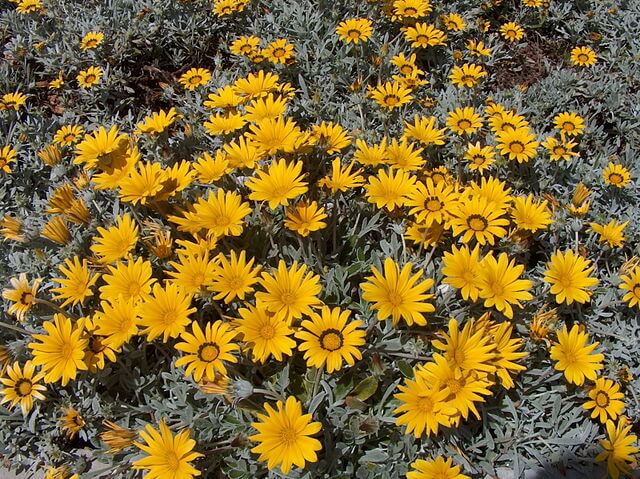

2.3. Peacock flicking - Gazania pavonia
Perennial, flowering, undersized, compact plant, often not exceeding 20 cm in height. Leaves are linear, green, glossy, reach a length of 20 cm, leaf blades often have pubescence on the lower surface. Inflorescences up to 8 cm in diameter, with orange or white petals and a dark stripe on the petals closer to the center.
You may also be interested in:
- Alstroemeria - flower photo, planting and care, growing in the open field and at home, description, varieties, soil composition for keeping home alstroemeria in a pot
- Rejuvenated - photo, planting and care in the open field, varieties of a stone rose, growing a flower at home, flowering time of a plant, composition of soil for keeping in a pot, description of a plant
- Saintpaulia - photo, violet varieties, home care, plant propagation, soil for growing indoor flowers, diseases and pests, transplantation, fertilization, watering
- Verbena - photo of a flower, planting and care in the open field, growing seedlings, a plant in a flower bed, medicinal properties, description, content in a pot and in a pots, height
- Monarda - photo, planting and care in the open field, medicinal properties of a flower, description of a plant, growing from seeds, use of essential oil, varieties, caring for a perennial at home, flowering time
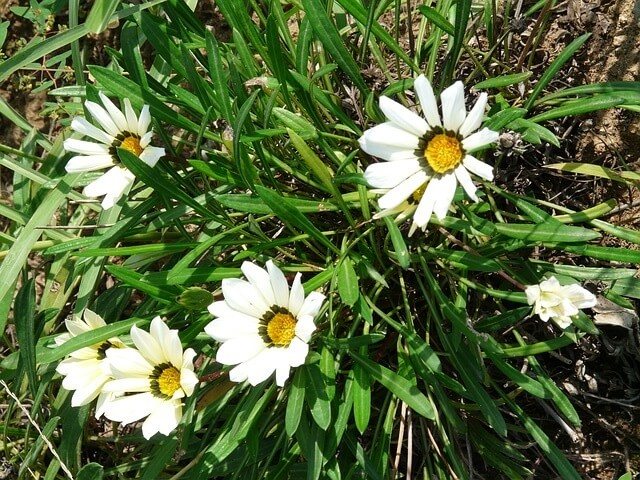

2.4.Gazania linearis
Compact herbaceous perennial up to 15 cm high with strong erect stems and dark green, narrow linear or lanceolate leaves. The leaf blades are glossy, entire, covered with silvery pubescence on the underside. Inflorescences are single flowers, reaching a diameter of 7.5 cm and have long, golden-yellow petals. Often there is a dark brown ring on the petals closer to the center.


2.5.Gazania Krebs - Gazania krebsiana
Perennials with large flowers and a very long flowering period are brightly and profusely blooming. Erect, branched at the base, the stems reach a height of 15 cm. The leaves are narrow, linear, dark green, glossy, reach a length of 17 cm. The lower surface of the leaf plates has light pubescence. Single flowers adorn this plant in the warm season and reach a diameter of 5 - 9 cm. The flower petals are painted in dark red or brick-orange, less often - white or yellow shades, sometimes with brown markings.
A distinctive feature of this plant is that it is the only gatsaniya in which, if damaged, the stem will release white milk.
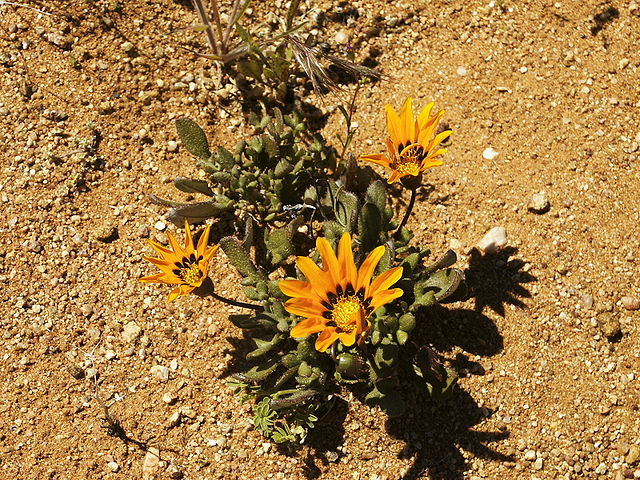

Choice of place and conditions of detention


Gatsania is an unpretentious and resistant plant that can grow and develop in almost any conditions. For decorative flowering and maintaining health, it is important to choose a place correctly, especially if you are growing a flower as a perennial.
Lighting and location
The plant is drought tolerant and photophilous. You need to choose a sunny place for landing, gating is not afraid of exposure to direct sunlight. With a lack of light, the saturation of the color of the petals decreases, the leaves lose their elasticity. The culture can be grown in open beds, as a curb plant or in a flowerpot, container. African chamomile looks especially decorative next to aster, marigold and pansies.
Temperature
Gatsania can survive a short-term exposure to cold, but in conditions of constant coolness, the appearance worsens, development slows down. The most comfortable temperature range is 18-24 ° C. Seedlings are exposed to cold, so planting should be planned so that the soil and air have time to warm up to 12-14 ° C. In the northern regions of the country, it is not recommended to leave the plant in the ground for the winter.
Air and humidity
Due to its low height, the flower is not affected by the wind, it is not afraid of drafts, so you can choose open places. Prefers moderate humidity, but gatsania can support growth in drought conditions. To maintain health and decorativeness, it is enough to observe moderate watering, spraying is not carried out.
Priming
Gatsania feels better in loose and light soil with good aeration and drainage. For planting, it is not recommended to choose a lowland and wetlands, as well as flower beds with a high occurrence of groundwater. For cultivation, chernozem, loamy or sandy loam soil with a neutral acidity level is suitable. You should not plant a plant close to a pond, where there is a high probability of decay of weak roots.
Rules for care and cultivation in the garden


Like all asters, gatsania is an unpretentious plant to care for. Regular watering is not required, but it is important to apply top dressing in a timely manner, to maintain a layer of mulch. If you grow the flower as a perennial plant, it should be provided with a comfortable wintering period.
Watering
When growing, you need to observe moderate watering, the regularity of the procedure is 2 times a week. In a dry period, planting can be watered more often, but be sure to monitor the condition of the soil, avoiding waterlogging.Gatsania can tolerate drought due to the villi on the leaves, but this is always reflected in the richness of the color of the buds. Water for irrigation should be warmed up to ambient temperature.
Top dressing
Fertilizers are applied every 2 weeks. As a top dressing, it is advisable to use organic matter, for example, a mullein solution diluted with water in a ratio of 1:10. The introduction of mineral compounds is also widely practiced, for example, superphosphate, potassium sulfate and ammonium nitrate at the rate of 5 g of the product per 10 liters of water. You can also use ready-made liquid dressings for flowering plants.
Loosening, mulching
Gatsania grows best on light soils, in order to maintain this condition, it is extremely important to regularly loosen. It is most convenient to do this after each watering, the loosening depth is 4-7 cm. In addition, throughout the summer you need to maintain a layer of mulch up to 8 cm thick. Sawdust, dry peat or straw are used as material for mulching.
Reproduction methods
Gatsania can be propagated by seed or cuttings. The collection of seeds is carried out in the fall, they must be removed in a timely manner and very carefully, since they quickly spread throughout the entire site. Seed material remains viable for up to 3 years.
A healthy part of the stem with a bud of growth is suitable as cuttings for propagation. The optimal length is 10 cm, the cutting is planted in a nutrient substrate for rooting within 1 month. After that, the plant can be transplanted into a flower bed.
Sowing African chamomile
Perennial gatsania, as already mentioned, is propagated by seeds. The seeds of this flower can be bought or collected on their own - they have excellent germination. It is necessary to sow gazania 1.5-2 months before the intended transplantation into the ground.


Early varieties of flowers are sown for seedlings in late February or early March. Gatsania with late flowering (blooms in late summer) is sown only in late March or early April.


To get strong gatsania seedlings, you need to follow the instructions:
- First you need to prepare the planting substrate. The best soil for African gatsania is considered to be a mixture of turf, humus, peat and sand, which are taken in equal parts. The acidity of the soil mixture must be neutral.
- Before sowing gatsania seeds, the soil should be disinfected. Any method is suitable: freezing, heating in the oven or watering with a solution of potassium permanganate. The main thing is that the soil for flowers is clean and does not contain pathogenic bacteria.
- Boxes and containers are selected for gating seedlings, they are filled with a substrate by about 70% of their volume.
- Now you need to water the soil with warm water and spread out the gatsania seeds, observing a checkerboard pattern. There should be about two centimeters of spacing between adjacent seeds in a row.
- Each grain of a flower is lightly pressed against the soil and the plantings are sprinkled with a thin layer of dry peat (about 5 mm).
- Now the top layer is slightly moistened with a spray bottle and the boxes are covered with foil.
- Gatsania seeds should be kept in a warm place with temperatures above 20 degrees until shoots begin to emerge. Until then, it is necessary to periodically moisten the soil using a spray bottle.
- When the seeds germinate in large quantities, the film is removed and the boxes with gatsania are placed in a brighter and cooler place.


Attention! Light is vital for Gatsania. In late winter or early spring, in most regions of Russia, there is not enough sunlight, therefore, African chamomile seedlings are supplemented with fluorescent lamps. If this is not done, the sprouts will become painful and over-stretched.
Be sure to dive gatsania seedlings when the plants have three true leaves. It must be remembered that the root system of a rod-type flower - the seedlings should be transferred very carefully, trying not to damage the central root.
Immediately before planting in the ground, the seedlings of flowers are hardened, gradually reducing the temperature in the room (by opening a window or balcony).
Advice! To avoid picking and not injure fragile gating, it is recommended to grow its seedlings in peat cups or tablets. When the time comes, organic containers of flower seedlings are simply placed in the holes in a flower bed or in a flowerpot.
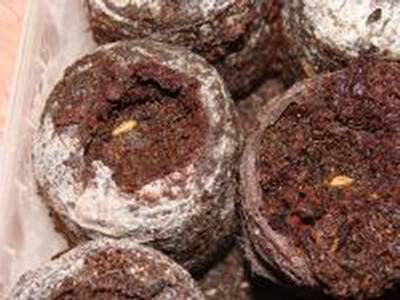

Application in design
Gaillardia flower: description, appearance, characteristics
Due to its variegated color and short stature, the gazania flower has gained great popularity among landscape designers and summer residents. It can be used to frame the edges of flower beds, plant along paths, create various patterns and shapes from it. It would be appropriate to place the gazania in rockeries among the stones.
Important! In order for gating to bloom for a long time, faded buds must be removed regularly.
The flower looks decorative from spring to autumn, so it can be used to decorate less expressive plants, planting in the foreground. In addition, gazania is grown in hanging baskets in combination with lobelia and pelargonium, placing them on the terrace, veranda, loggia, balcony. The flower will look no less impressive in garden vases and pots in the local area.
Gatsania care
How to grow gatsania.
The conditions for growing gatsania, as already mentioned, are bright sunlight and well-drained soil. But, despite its love for warmth, gatsania can also endure sharp cold snaps up to -5. -7 ºC. Caring for gatsania in the garden consists in moderate watering, followed by loosening the soil and removing weeds and timely removal of wilted inflorescences so that the plant forms new buds faster. Mulching of the soil is also encouraged, which allows it to retain moisture in the soil longer in the summer heat and reduces the amount of weeds on the site. Growing gatsania flowers also provides for fertilizing: if your gatsaniya grows on fertile soil, you need to feed it once a month and a half with a solution of complete mineral fertilizer at the rate of 20-25 g per square meter, but if you planted it on stony, poor soil, then you will have to fertilize once every 2-4 weeks.
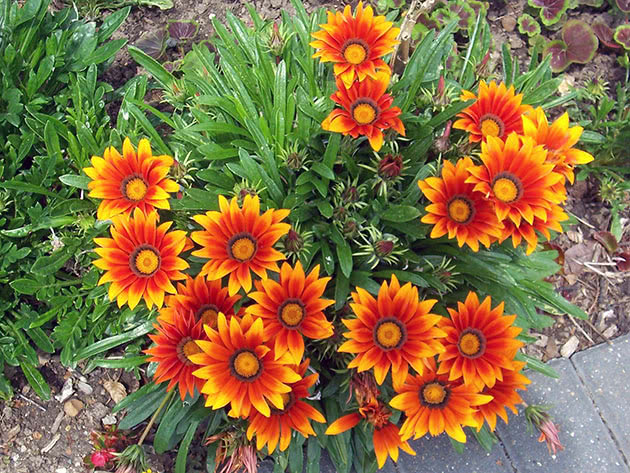

Blooming gatsania.
Gatsania blooms from June to November, and each basket blooms for about three weeks. In the dark and in cloudy weather, the reed flowers of the gatsania curl up, covering the yellow middle of the tubular flowers. Sometimes flower growers complain that gatsania does not want to bloom. This may be due to insufficient lighting, excessive watering, or too late transplanting seedlings into open ground. Try not to violate the agrotechnical requirements of gatsania, and it will bloom on time and abundantly.


Gatsania pests and diseases.
Anyone who has grown gatsania will tell you that she is not sick. But if the growing conditions are unfavorable for the plant, it weakens, and then it can be affected by gray rot. We'll have to remove diseased specimens and treat the rest of the plants with phytosporin. Among insects, snails, aphids and spider mites harm gatsaniya. Snails must be collected by hand, and insects are destroyed with insecticides: aphids - with phytoverm, acarin, inta-vir, and spider mites - with actellik, fufanon or ditox.
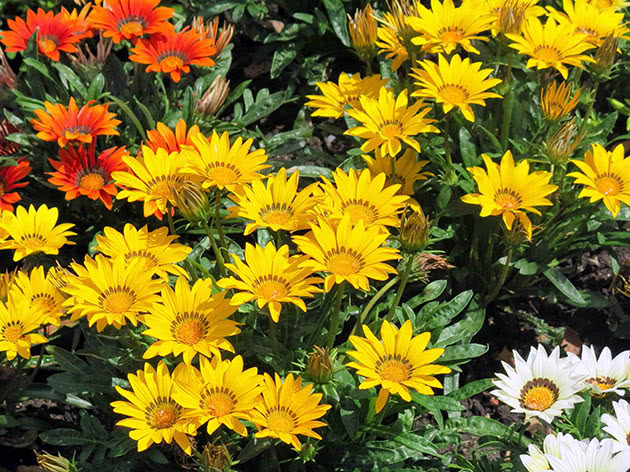

Gazania wintering
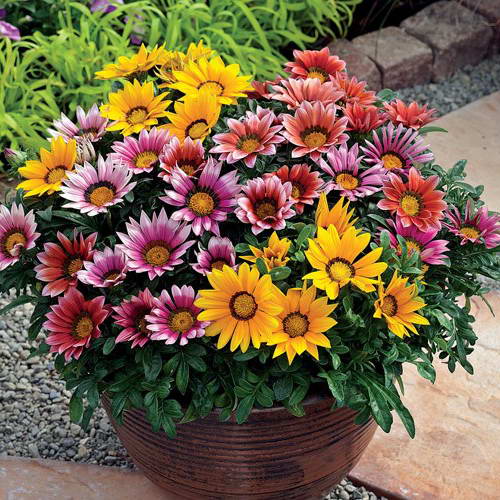

Potted gatsania can continue growing in winter
Usually, after flowering, the remnants of gatsania are simply cut off and thrown away, and the next year they start all over again. There is no need to prepare seeds, sow, wait for good weather. An old plant is capable of blooming again, delighting with its beauty for the next year. To do this, it can be dug up and transplanted into a pot.
Then gating should be transferred to a cool room, where the temperature does not drop to 8-10. There should be enough light in this room for gazania to develop further. The dormant plant must be watered, the earth must not dry out. In the spring, you can re-plant the gazani in the flower bed. New, re-emerged shoots, while you need to cut off in half.
New plants are obtained from cuttings of gazania; it is enough to simply dip them into the water until the roots appear, or simply immediately plant them in the nutrient mixture, ensuring abundant watering. In winter, gatsania can be cut off and new full-fledged seedlings can be obtained by spring.
Properties and environment requirements
Gazania is native to arid places, so it does not like excess moisture and heavy soils. In all other respects, it is quite hardy: it is not afraid of frost, heat, winds, temperature changes. Gatsania flowers can be released all summer, for which it is appreciated. Under natural conditions of a temperate climate, it is difficult to provide this plant with the opportunity to go through a two-year cycle. But in the fall, it can be transplanted into a flower pot and placed on a windowsill.
Most growers grow gazania from seed and cultivate it as an annual.
At the same time, the timing of sowing seeds for seedlings depends on the climatic features of the area. If spring is late, then you need to plant seedlings no earlier than the end of May. In this case, the seedlings will have to be fed and specially illuminated. In early spring, there will be less hassle with seedlings. If you are ready to wait with the flowering of gatsania, then in favorable conditions of a short winter, you can do without seedlings at all: sowing seeds directly into the ground will relieve the flowers of the stress of transplanting.


One gatsania bush has 9 inflorescences, which blooms for 15-20 days.
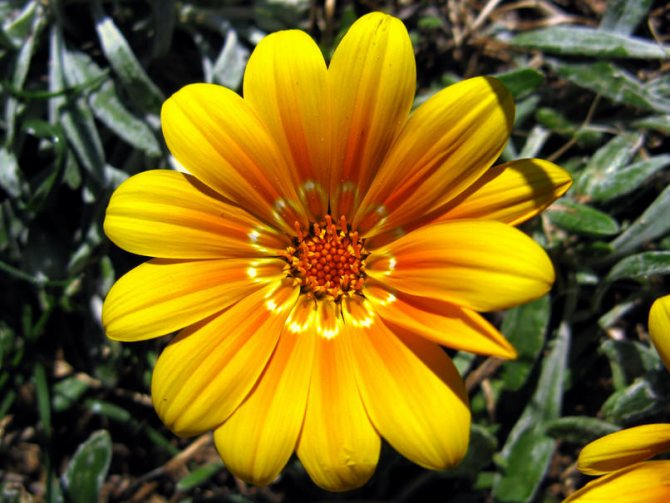

Yellow gatsaniya from warm Africa.
Preparing for landing
The planting site must be prepared in the fall. The site should be dug to the depth of the shovel bayonet, remove all plant debris, stones and roots. After that, add organic matter, for example, cow dung at the rate of 4 kg / m2.
To grow seedlings, you need to prepare a common container, if you immediately use a deep container, you can do without picking into individual pots. The seeds have a high germination capacity and a long shelf life; they are not processed before planting.
Origin and names
photo of gatsania
Many people ask gazania or gatsaniya what is the correct name for the flower? You should know and remember that both names are correct. Among the people, it is also called African chamomile. After all, it originates in Mozambique, a hot and exotic country, from where it was brought to the territory of Europe, and later nicknamed “Nomad from Mozambique”.
Europeans have their own name for this flower, which sounds like "Mittagsgold" or "midday gold". She received the second name due to the fact that her petals open at the zenith of half a day.
If you take proper care of the midday sun, it will delight you with its lush bloom for a long time.
Astrovids include a wide variety of representatives. Among them, it is worth noting the unusual and mesmerizing beauty of gazania, which belongs to this family. Agree that it is a more "improved" copy of the garden aster. This is one of the most spectacular plants that are found among the many representatives of the aster. As a rule, they belong to Compositae perennials.
In nature, except for Mozambique, it is found in the vast territories of Africa and Australia.
Gazania flower description photo
Distinctive feature! As soon as clouds appear in the sky or the sun sets over the horizon, the shy woman hides the petals in the buds.
motley gazania
The midday sun is a low plant, which reaches no higher than 30 cm. The roots have a so-called rosette, from which leaves immediately grow. Some of the representatives have a stem, but only they have a very small one. The edges of the green foliage are jagged and come in a wide variety of shapes. The lower part of the dense leaves has silvery funnels that perfectly retain moisture, and also help fight cloudy and cold days.
Thanks to the taproot, which goes deep into the soil throughout its life, gazania is able to extract water from the soil.
Flowering begins in mid-summer and ends with the onset of the first light frosts.Sometimes there are flowering bushes, even in spite of the snow that has fallen. This feature is inherent in varieties with villi that protect them from slight cold weather. The formation of peduncles (25 cm) occurs in the outlet. Flowers collected in baskets adorn the topmost point of the bush. The circumference of the inflorescences varies from 4 to 10 cm. When flowering begins, as well as the size of the inflorescences, depends on which species you decide to opt for.
Each of the inflorescences lives no more than 3 weeks... There are about 6-9 baskets on the bush, which open alternately, which allows you to enjoy flowers for about 3.5 months. In the baskets, reed flowers are collected, located at the edges, the central part is decorated with tubular flowers, in which seedlings are formed.
African chamomile gazania has a wide variety of shades that vary from white to deep red. With the help of dark spots that adorn the petals, the flowers look quite unusual and unforgettably beautiful. They are located at the base and form an original pattern that resembles a peacock's tail.
As soon as the buds wilt, be sure to cut them back to allow new buds to bloom.
Transferring seedlings to the ground
It is necessary to plant gatsaniya in a flower bed when a stable warm temperature and good weather are established. Usually, this happens in mid-May (early varieties of flowers in the southern regions are planted in early May). At a later time, the seedlings may "burn" under the hot rays of the spring sun.
The soil for an African flower should be fertile and light. If the soil in the flowerbed is depleted, before planting it is fertilized with humus, ash or mineral complexes.
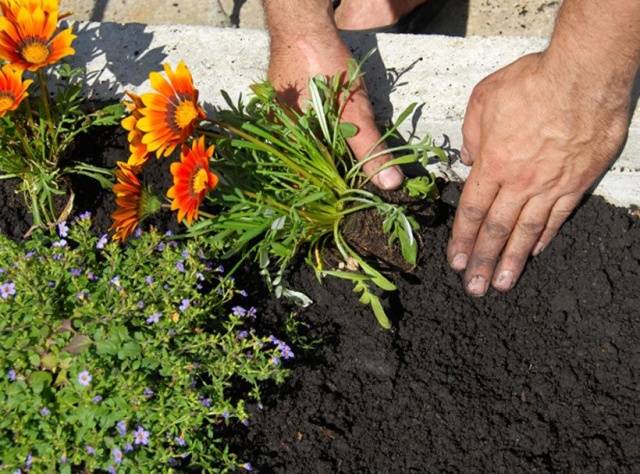

Planting gatsaniya is carried out according to the scheme 20x20 or 25x25 cm. Tall varieties should be planted at large intervals. After planting, the flower bed is watered with warm water and covered with agrofibre to protect the gazania from the cold and sun. After a few days, the shelter from the flowers must be removed.
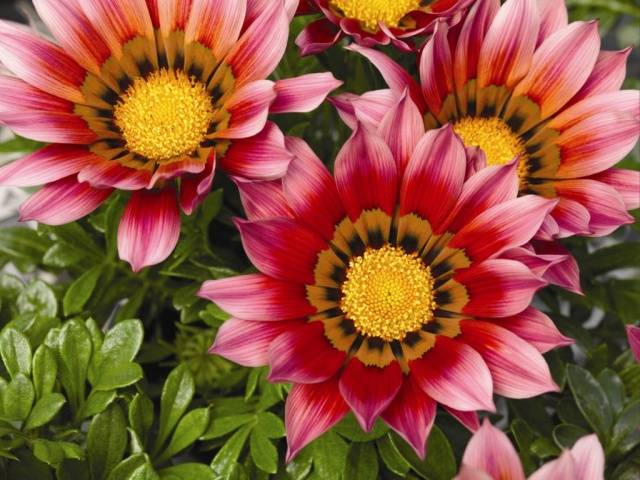

Attention! Adult gatsaniya is able to withstand a temperature drop down to -7 degrees, but young seedlings do not like cold very much.
Flowering perennial gatsania
A description of the gatsania bloom can be found in any source, but if you see a flower once, it will remain in your memory for a long time. Baskets with a diameter of 3-9 cm, often of yellow or orange tones, are somewhat reminiscent of a gerbera. There are also red, pink, white flowers with a dark longitudinal stripe on shiny petals. At the same time, several buds bloom on a low plant (15-30 cm). Those that have faded in 1-2 weeks are replaced by new ones.
It is better to remove faded beauty. So the plant looks neater, and the formation of new buds is more intense.
The flowering phase begins quite late, only by mid-June, but it lasts until the very cold. This feature should be taken into account when planning the design of a future flower bed.


Photo:
Types, varieties
The genus Gatsania has about 40 species, some of which are grown as an ornamental plant. Popular varieties:
- Shiny... It has tubular buds colored red-black or yellow. There are white spots at the base;
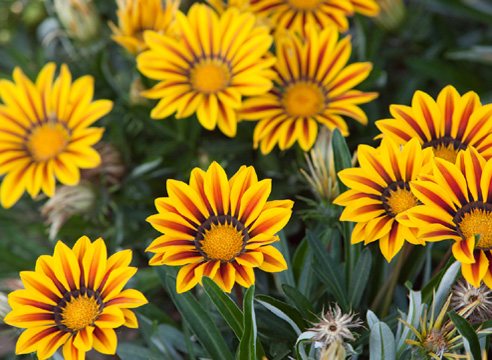

- Potsey... Outwardly, it resembles a brilliant gatsaniya, it differs only in the diameter of the flowers, which can reach up to 11 cm in diameter;
- Long rifle... Grown as an annual plant. It grows up to 20 cm, the flowers are tubular or ligulate, painted in a yellow-brown hue;


- Peacock... Differs in decorative long leaves. The flowers are large, colored orange or yellow (see photo).


On sale there are varieties of pinnate, single-flowered and hybrid gatsania. For planting in unfavorable climatic conditions, it is recommended to choose exactly hybrids - they have increased resistance and vitality. Popular hybrid varieties: Ministar, Daybreak Red Stripe, Talent.
When to plant


As a rule, the plant is grown by seedling method.Sowing seeds is carried out from late February to mid-March, and towards the end of spring, grown plants can already be transplanted into open ground. In warm regions of the country, it is permissible to plant gatsania directly to a permanent place with seeds. In this case, planting is carried out not earlier than the end of April, you should wait until the air warms up to stable warm values, there will be no threat of night frosts.
How to harvest gazania seeds
In hot and long summers, any gardener can harvest a sufficient amount of ripe gazania seeds. It should be remembered that the seeds of hybrid gazanias do not retain their species differences. To prevent ripe seeds from scattering from the wind, each flower head must be protected by wrapping it with gauze.


After a light cannon appears on a faded basket, it must be ripped off and left in a dark place for 2 weeks. It is necessary to store the seeds in a cool place in a paper bag, on which it is convenient to make notes about the flower. Gazania seeds remain viable for 2 years.
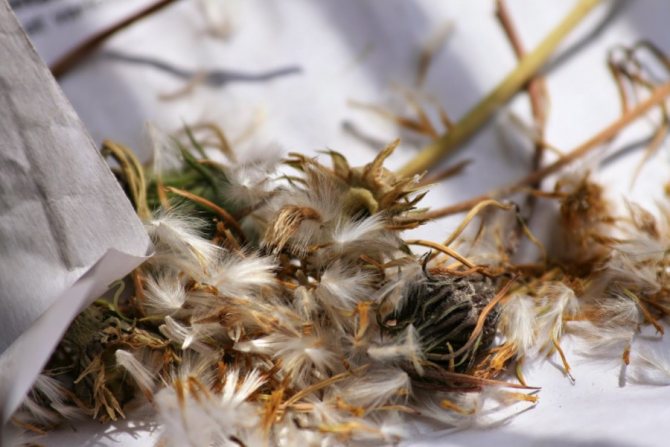

Selection and variety series
With the active work of breeders, many interesting varieties of gatsania garden flower have been bred, the most popular of them are:
- Daybreak series - presented in bright yellow, golden tangerine and hot orange shades, as well as red-brown.
- Kiss varieties are distinguished by low-growing plants up to 25 cm in height, inflorescences up to 10 cm in diameter.
- Chansonette - differs in two-tone inflorescences of various shades;
- The Talent series is one of the new, but popular among flower growers, plant height up to 20 cm, characteristic feature: silvery olive-colored leaves, which perfectly contrast with flowers, do not close at night.
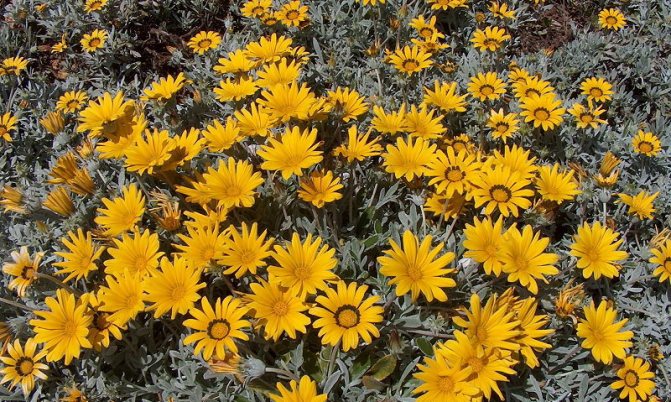

- Sundance varieties - have large flowers, 2-color color (bright yellow edges and burgundy stripe along the entire length of the petal).
- Harlequin - it is distinguished by a large bush, the color of the flowers is bright red-orange with a central dark red stripe.


Gatsania after flowering
Seed collection
In middle latitudes, the seeds of such a plant most often do not ripen. This can only happen if the summer period is relatively dry, sultry and long. It should also be remembered that, as a rule, hybrid varieties of such a plant are cultivated, and their seeds do not have the ability to retain the varietal characteristics of the parent plant. And we must also remember that ripe gatsania inflorescences are very similar to dandelion, with a strong gust of wind, the seeds simply fly away. In this regard, the fading baskets must be wrapped with gauze, which is fixed on the peduncle, so that the seeds remain in place.
Wintering
If you are cultivating an annual plant, then when it has faded, the residues are removed and burned. However, some gardeners keep it for the next year. Choose the most spectacular bushes that still need to bloom. They are dug up and planted in containers or pots. After that, they are placed in a cool (8 to 10 degrees) room with good lighting. Watering should be rare and abundant, but the earthen coma should not be allowed to completely dry out. In spring, they are planted in the garden, while their stems should be shortened by ½ part.
Varieties and varieties
The most common types of annual gatsania flowers are:
- Hybrid, growing in a low bush, which has oblong leaves collected in a basal rosette. The size of bright flowers in this species is 7-9 cm, inside each there are dark spots in the form of oval patterns. Flowering takes place from the end of June until frost, 6-9 inflorescences bloom at the same time, each flowering lasts up to 20 days. Thus, each plant blooms for 90-100 days.
- Gatsania long-arrow is distinguished by creeping stems with narrow leaves, yellow flowers with a white border and a dark circle in the middle have a diameter of about 7 cm, are placed on high peduncles. Flowering time lasts from August until frost, flowers close every evening. After removing dried buds, new ones appear almost immediately.During cloudy weather, the plant does not open flowers.


Growing features
Diseases and pests infest gatsaniya extremely rarely, usually infection is observed when cultivation agrotechnics and care rules are not followed. Root rot is the most dangerous. If an infection is detected, all heavily damaged bushes must be removed, the rest of the planting must be treated with Fitosporin solution, and the procedure must be repeated after 12 days.
Among the pests, the most dangerous are aphids, spider mites and snails. The latter need to be harvested by hand, gradually reducing the population. To control insects, synthetic insecticides or acaricides are used.
Gatsania is an ornamental plant widely used for growing in flower beds, outdoor lawns or next to curbs. For abundant and rich flowering, it is important to choose the right planting site and follow the minimum care rules. The flower is unpretentious and easy to grow, suitable for beginners.
Gazania: photos
Types and varieties of gazania with photos and descriptions
Gazania long rifle Gazania longiscapa
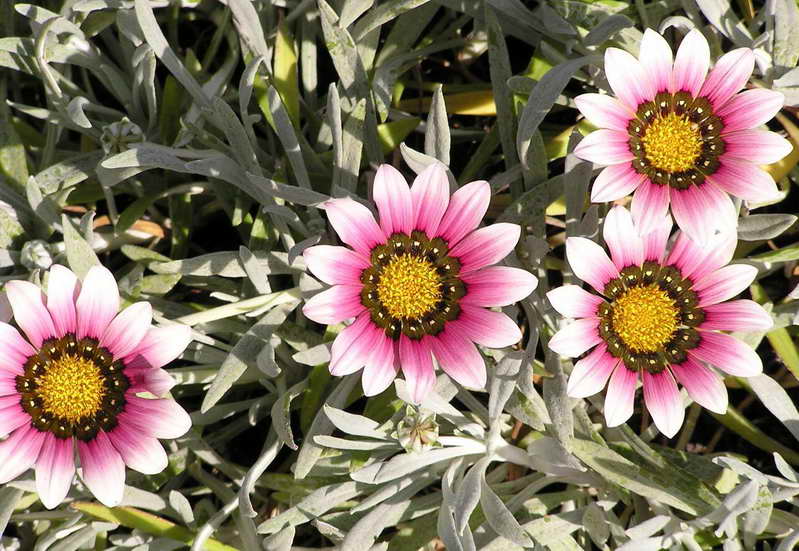

Gazania long rifle Gazania Longiscapa Purple-Pink-Orange photo
It can bloom for only one year. This gazania does not grow more than 15-20 cm. Near the roots there are whole-cut leaves of bright green color. They usually come down from the bottom. Many tubular and reed flowers can be found in the basket. The flowers themselves are bright yellow in color, but their base is brown.
Gazania harsh Gazania rigens, or brilliant - Gazania splendens


Gazania harsh Gazania rigens, or brilliant - Gazania splendens photo
Grows up to 30 centimeters. Gazania rigens baskets can be up to 6 centimeters in diameter. Flowers can be tubular, blood black and ligulate, and range in color from yellow to red. There are dark spots at the base as expected. Leaves can be whole or pinnate.
Gazania pottsii Gazania pottsii
Strongly resembles harsh, but has a larger size. The diameter of the basket is about 12 centimeters.
Peacock Gazania Gazania pavonia


Gazania peacock Gazania pavonia cultivar Daybreak Red Stripe photo
The leaves of this species are different from those of the other gatsania listed above - they are narrow and long. The basket diameter is 8 centimeters. The middle consists of only one tubular flowers, the base is dark, and along the edges ligulate flowers of yellow shades.
When crossing some plant species, breeders were able to get a snow-white, feathery, hybrid, one-flowered gating. The hybrid species can delight with its flowering even in bad weather, when there is no sun at all.
Gazania hybrid
Hybrid varieties that are popular with gardeners: Daybreak Red Stripe - yellow flowers with stripes of red, blooming full daylight hours; Talent - a mixture that gives beautiful flowers, leaves all sunny day; Ministar - gives flowers of yellow and white color, distinguished by special beauty.
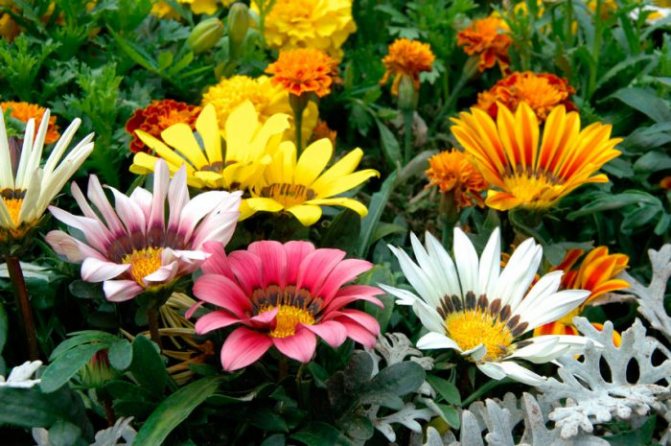

A plant such as Gazania is also called African chamomile or gazania. It is directly related to the aster family. This genus includes about 40 different species. In natural conditions, they can be found in South Africa and Mozambique, and also in the coastal dunes of Australia. In European countries, they learned about this flower in the 17th century, at which time it acquired its current name in honor of the Italian Theodor von Gaza, who was a priest who translated the works of Theophrastus and Aristotle. In Western Europe, such flowers are also called "midday gold". The fact is that flowers with a warm color bloom at noon.






